Nursing Education: Theories, Models, and Clinical Practice Analysis
VerifiedAdded on 2023/04/21
|18
|4658
|278
Report
AI Summary
This report provides a comprehensive overview of teaching and learning in nursing education. It begins with an introduction to the importance of teaching and learning in the nursing field, followed by a discussion of various teaching and learning theories and models, including behaviourism, cognitive theories (Piaget and Vygotsky), constructivism, and humanistic approaches. The report then delves into a model for clinical nursing education and training, outlining the roles of different stakeholders such as educators, learners, and clinical settings. It emphasizes the role of teaching and education support in clinical practice, covering topics such as curriculum, learning styles, and behavior system models. Furthermore, the report addresses education and training needs analysis, including what training is needed and how to design, implement, and evaluate nursing education strategies, concluding with a summary of the key points and a list of references.
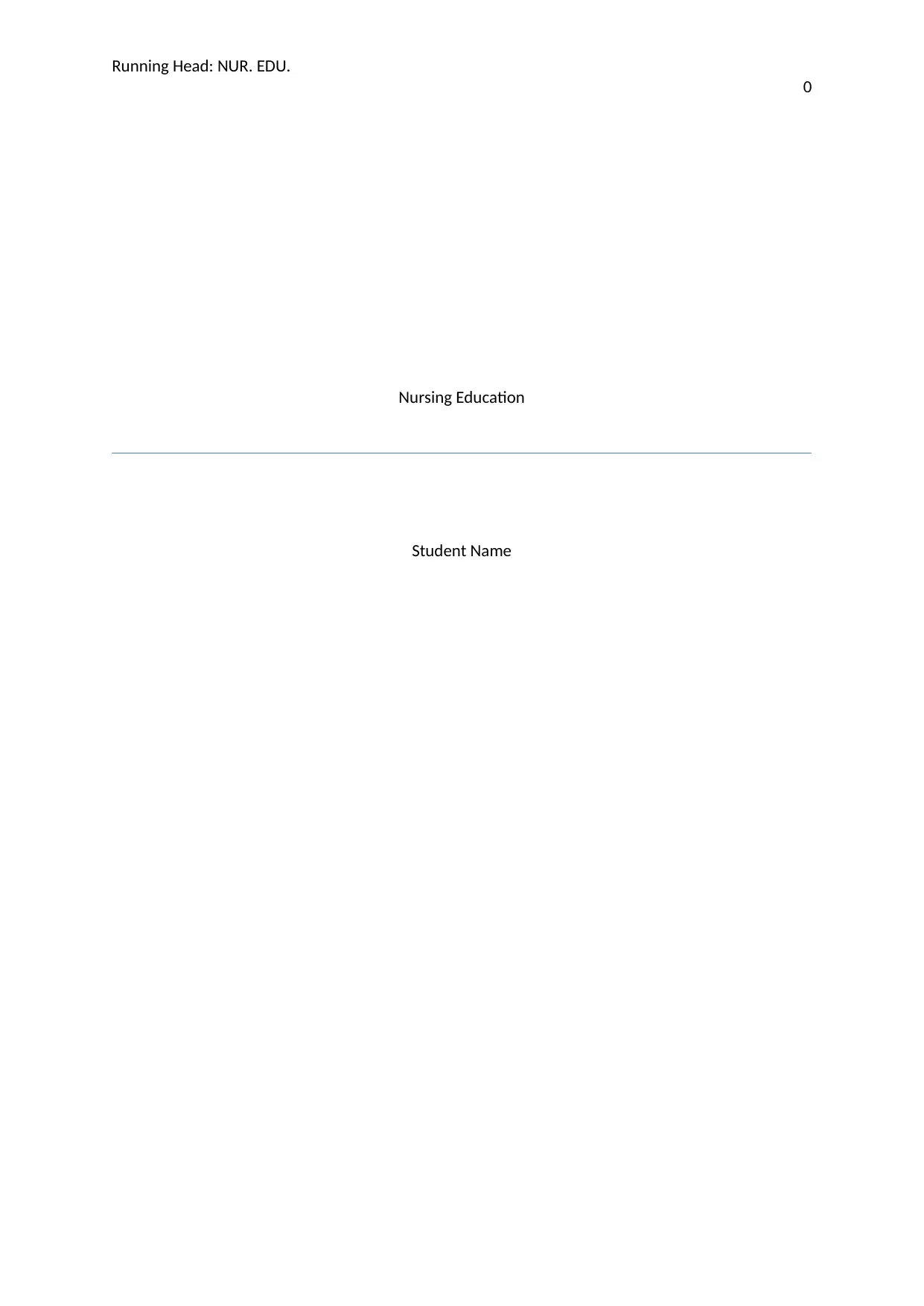
Running Head: NUR. EDU.
0
Nursing Education
Student Name
0
Nursing Education
Student Name
Paraphrase This Document
Need a fresh take? Get an instant paraphrase of this document with our AI Paraphraser
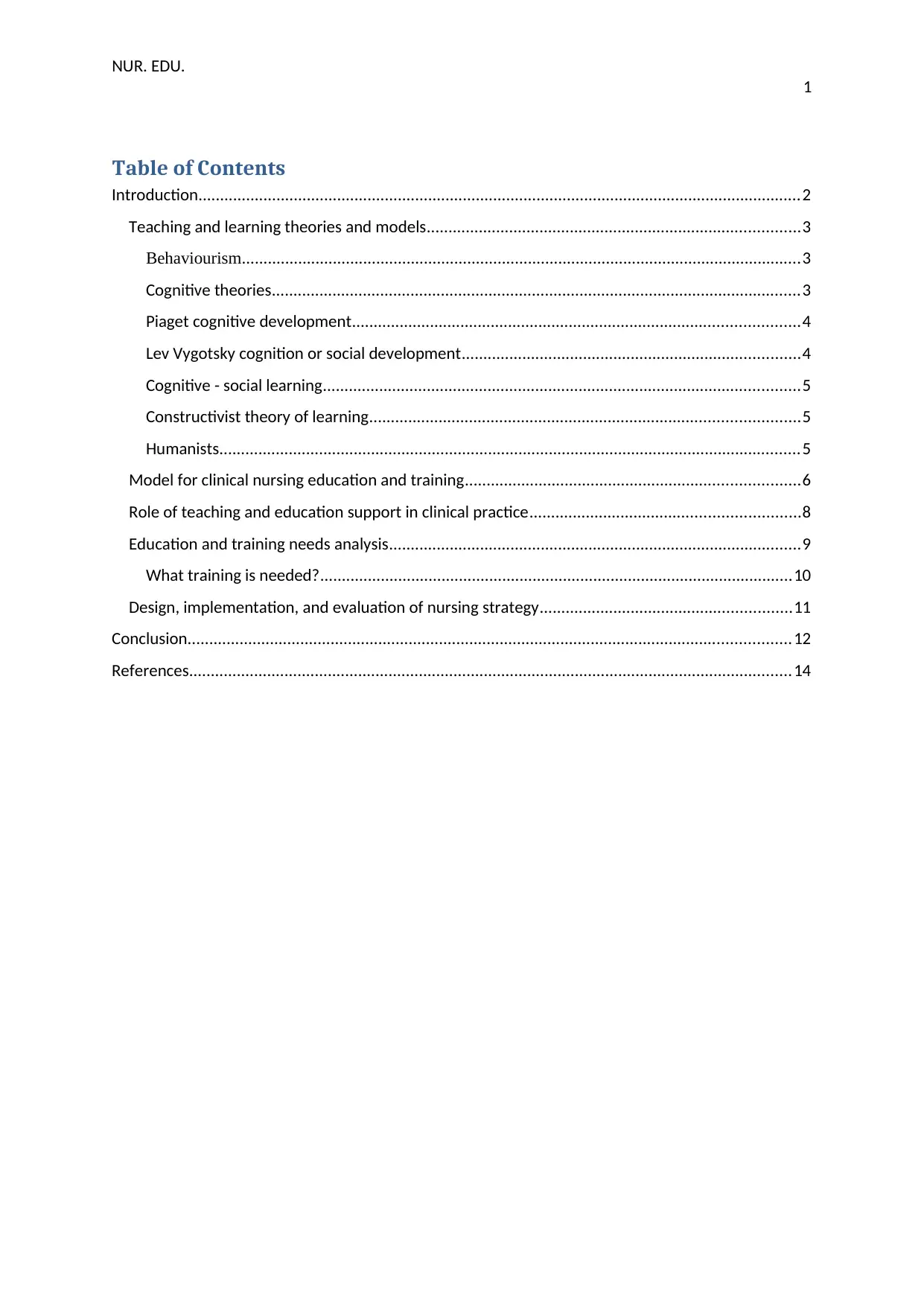
NUR. EDU.
1
Table of Contents
Introduction...........................................................................................................................................2
Teaching and learning theories and models......................................................................................3
Behaviourism.................................................................................................................................3
Cognitive theories..........................................................................................................................3
Piaget cognitive development.......................................................................................................4
Lev Vygotsky cognition or social development..............................................................................4
Cognitive - social learning..............................................................................................................5
Constructivist theory of learning...................................................................................................5
Humanists......................................................................................................................................5
Model for clinical nursing education and training.............................................................................6
Role of teaching and education support in clinical practice..............................................................8
Education and training needs analysis...............................................................................................9
What training is needed?.............................................................................................................10
Design, implementation, and evaluation of nursing strategy..........................................................11
Conclusion...........................................................................................................................................12
References...........................................................................................................................................14
1
Table of Contents
Introduction...........................................................................................................................................2
Teaching and learning theories and models......................................................................................3
Behaviourism.................................................................................................................................3
Cognitive theories..........................................................................................................................3
Piaget cognitive development.......................................................................................................4
Lev Vygotsky cognition or social development..............................................................................4
Cognitive - social learning..............................................................................................................5
Constructivist theory of learning...................................................................................................5
Humanists......................................................................................................................................5
Model for clinical nursing education and training.............................................................................6
Role of teaching and education support in clinical practice..............................................................8
Education and training needs analysis...............................................................................................9
What training is needed?.............................................................................................................10
Design, implementation, and evaluation of nursing strategy..........................................................11
Conclusion...........................................................................................................................................12
References...........................................................................................................................................14
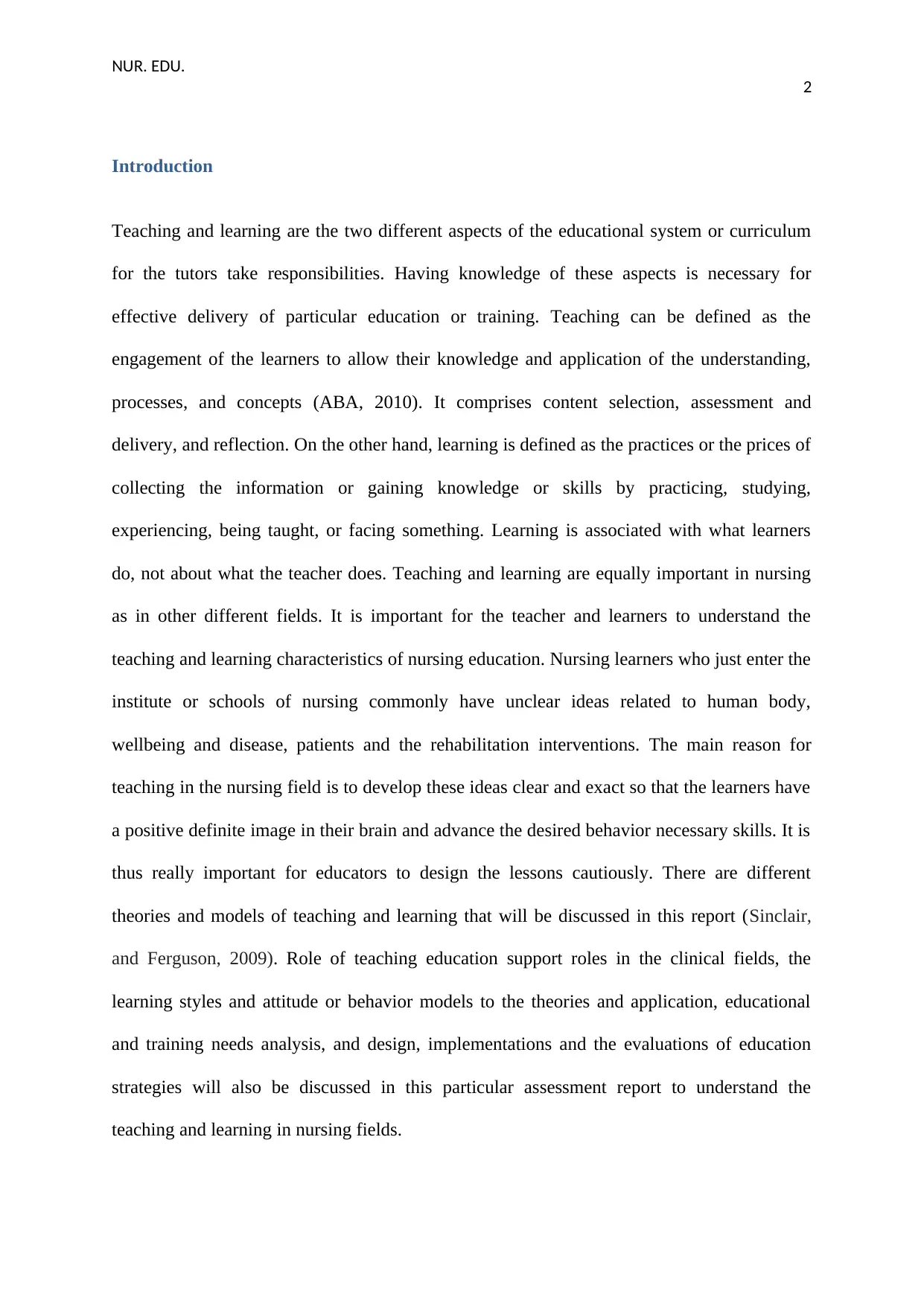
NUR. EDU.
2
Introduction
Teaching and learning are the two different aspects of the educational system or curriculum
for the tutors take responsibilities. Having knowledge of these aspects is necessary for
effective delivery of particular education or training. Teaching can be defined as the
engagement of the learners to allow their knowledge and application of the understanding,
processes, and concepts (ABA, 2010). It comprises content selection, assessment and
delivery, and reflection. On the other hand, learning is defined as the practices or the prices of
collecting the information or gaining knowledge or skills by practicing, studying,
experiencing, being taught, or facing something. Learning is associated with what learners
do, not about what the teacher does. Teaching and learning are equally important in nursing
as in other different fields. It is important for the teacher and learners to understand the
teaching and learning characteristics of nursing education. Nursing learners who just enter the
institute or schools of nursing commonly have unclear ideas related to human body,
wellbeing and disease, patients and the rehabilitation interventions. The main reason for
teaching in the nursing field is to develop these ideas clear and exact so that the learners have
a positive definite image in their brain and advance the desired behavior necessary skills. It is
thus really important for educators to design the lessons cautiously. There are different
theories and models of teaching and learning that will be discussed in this report (Sinclair,
and Ferguson, 2009). Role of teaching education support roles in the clinical fields, the
learning styles and attitude or behavior models to the theories and application, educational
and training needs analysis, and design, implementations and the evaluations of education
strategies will also be discussed in this particular assessment report to understand the
teaching and learning in nursing fields.
2
Introduction
Teaching and learning are the two different aspects of the educational system or curriculum
for the tutors take responsibilities. Having knowledge of these aspects is necessary for
effective delivery of particular education or training. Teaching can be defined as the
engagement of the learners to allow their knowledge and application of the understanding,
processes, and concepts (ABA, 2010). It comprises content selection, assessment and
delivery, and reflection. On the other hand, learning is defined as the practices or the prices of
collecting the information or gaining knowledge or skills by practicing, studying,
experiencing, being taught, or facing something. Learning is associated with what learners
do, not about what the teacher does. Teaching and learning are equally important in nursing
as in other different fields. It is important for the teacher and learners to understand the
teaching and learning characteristics of nursing education. Nursing learners who just enter the
institute or schools of nursing commonly have unclear ideas related to human body,
wellbeing and disease, patients and the rehabilitation interventions. The main reason for
teaching in the nursing field is to develop these ideas clear and exact so that the learners have
a positive definite image in their brain and advance the desired behavior necessary skills. It is
thus really important for educators to design the lessons cautiously. There are different
theories and models of teaching and learning that will be discussed in this report (Sinclair,
and Ferguson, 2009). Role of teaching education support roles in the clinical fields, the
learning styles and attitude or behavior models to the theories and application, educational
and training needs analysis, and design, implementations and the evaluations of education
strategies will also be discussed in this particular assessment report to understand the
teaching and learning in nursing fields.
⊘ This is a preview!⊘
Do you want full access?
Subscribe today to unlock all pages.

Trusted by 1+ million students worldwide

NUR. EDU.
3
Background
Nursing, particularly in Ireland, is presently witnessing a significant training and educational
reform by the procedure of affiliation with the institutes of higher education (Government of
Ireland (2011). The nursing curriculum improvement specifically in Ireland has change form
supporting basic standard structured education towards an approach which appears to help
educationally led different programs and experience (Suresh, Matthews, and Coyne, 2013).
Nursing education programs in nursing have been implemented in 1995. It was an attempt to
nurture the additional widely educated, additional analytical and self-oriented profession. The
nursing education forum was set up in February 1999, as suggested by the commission on
nursing (Nursing and Midwifery Board of Ireland, 2014).
Requirements
Teaching and learning theories and models
Behaviourism
Behaviourism has become the leading methodology in psychology investigations. At the
starting of the twentieth century, previous behaviorists supposed that learning is the alteration
in noticeable nature and it takes place when the interaction happens among the two occasions,
an inducement, and a reaction. Between the uses of this method is the effect on the student's
expressive responses. An emotional reaction to knowledge may be favorable or unfavorable.
Negative involvements can result in fear or worry. The panic and worry in the future alike
circumstances, even after simplification, incite in other conditions as well such unfriendly
emotional state. The philosophy of transponders habituation or Pavlov classical preparing is
one of those interactive beliefs. This philosophy is useful in nursing. Learners in a medical
setting come across a number of dissimilar facts, which require different joint forces. Thus, it
3
Background
Nursing, particularly in Ireland, is presently witnessing a significant training and educational
reform by the procedure of affiliation with the institutes of higher education (Government of
Ireland (2011). The nursing curriculum improvement specifically in Ireland has change form
supporting basic standard structured education towards an approach which appears to help
educationally led different programs and experience (Suresh, Matthews, and Coyne, 2013).
Nursing education programs in nursing have been implemented in 1995. It was an attempt to
nurture the additional widely educated, additional analytical and self-oriented profession. The
nursing education forum was set up in February 1999, as suggested by the commission on
nursing (Nursing and Midwifery Board of Ireland, 2014).
Requirements
Teaching and learning theories and models
Behaviourism
Behaviourism has become the leading methodology in psychology investigations. At the
starting of the twentieth century, previous behaviorists supposed that learning is the alteration
in noticeable nature and it takes place when the interaction happens among the two occasions,
an inducement, and a reaction. Between the uses of this method is the effect on the student's
expressive responses. An emotional reaction to knowledge may be favorable or unfavorable.
Negative involvements can result in fear or worry. The panic and worry in the future alike
circumstances, even after simplification, incite in other conditions as well such unfriendly
emotional state. The philosophy of transponders habituation or Pavlov classical preparing is
one of those interactive beliefs. This philosophy is useful in nursing. Learners in a medical
setting come across a number of dissimilar facts, which require different joint forces. Thus, it
Paraphrase This Document
Need a fresh take? Get an instant paraphrase of this document with our AI Paraphraser

NUR. EDU.
4
is comprehensively deprived of being irresistible to collateralize all the powers collected
(Aliakbari, et al., 2015).
Cognitive theories
Aliakbari, Parvin, Heidari, and Haghani, (2015) stated that learning is the directed internal
practice and concentrates on thinking, understanding, establishing, and awareness. This kind
of educational therapy cannot be perceived openly and it is related to the alteration in
capability and capacity of the individual to counter. Basically, it does not directly variation in
the behaviour. The fundamentalists consider that the learners should be prepared to
interrogative abilities and problem elucidating, therefore by consideration and info handling,
they may be capable to learn vigorously, resolving and looking for novel info, and revising
their earlier involvements for healthier knowledge. Gestalt philosophy is recognized as the
most popular of learning intellectual philosophies. According to Lisko, and O'dell, (2010)
Theological implication learning philosophy of David Ausubel is considered as the well-
recognized philosophy of cognition or intellect. The association of this philosophy with
institute education is higher than different other concepts of learning since this philosophy
has been advanced in standard to clarify spoken learning issues in constituents. Educators can
apply a range of ways to enhance learning and remembering (Aliakbari, et al., 2015).
Piaget cognitive improvement
Teaching technique grounded on the Piaget's philosophy is concentrated on investigative
learning or education. In this technique, the students can identify the ideas and ideologies
individually and not by the description and explanation of the educator. This will help the
student to learn nursing concepts clearly and in a practical way (Demetriou, Shayer, and
Efklides, 2016)
4
is comprehensively deprived of being irresistible to collateralize all the powers collected
(Aliakbari, et al., 2015).
Cognitive theories
Aliakbari, Parvin, Heidari, and Haghani, (2015) stated that learning is the directed internal
practice and concentrates on thinking, understanding, establishing, and awareness. This kind
of educational therapy cannot be perceived openly and it is related to the alteration in
capability and capacity of the individual to counter. Basically, it does not directly variation in
the behaviour. The fundamentalists consider that the learners should be prepared to
interrogative abilities and problem elucidating, therefore by consideration and info handling,
they may be capable to learn vigorously, resolving and looking for novel info, and revising
their earlier involvements for healthier knowledge. Gestalt philosophy is recognized as the
most popular of learning intellectual philosophies. According to Lisko, and O'dell, (2010)
Theological implication learning philosophy of David Ausubel is considered as the well-
recognized philosophy of cognition or intellect. The association of this philosophy with
institute education is higher than different other concepts of learning since this philosophy
has been advanced in standard to clarify spoken learning issues in constituents. Educators can
apply a range of ways to enhance learning and remembering (Aliakbari, et al., 2015).
Piaget cognitive improvement
Teaching technique grounded on the Piaget's philosophy is concentrated on investigative
learning or education. In this technique, the students can identify the ideas and ideologies
individually and not by the description and explanation of the educator. This will help the
student to learn nursing concepts clearly and in a practical way (Demetriou, Shayer, and
Efklides, 2016)
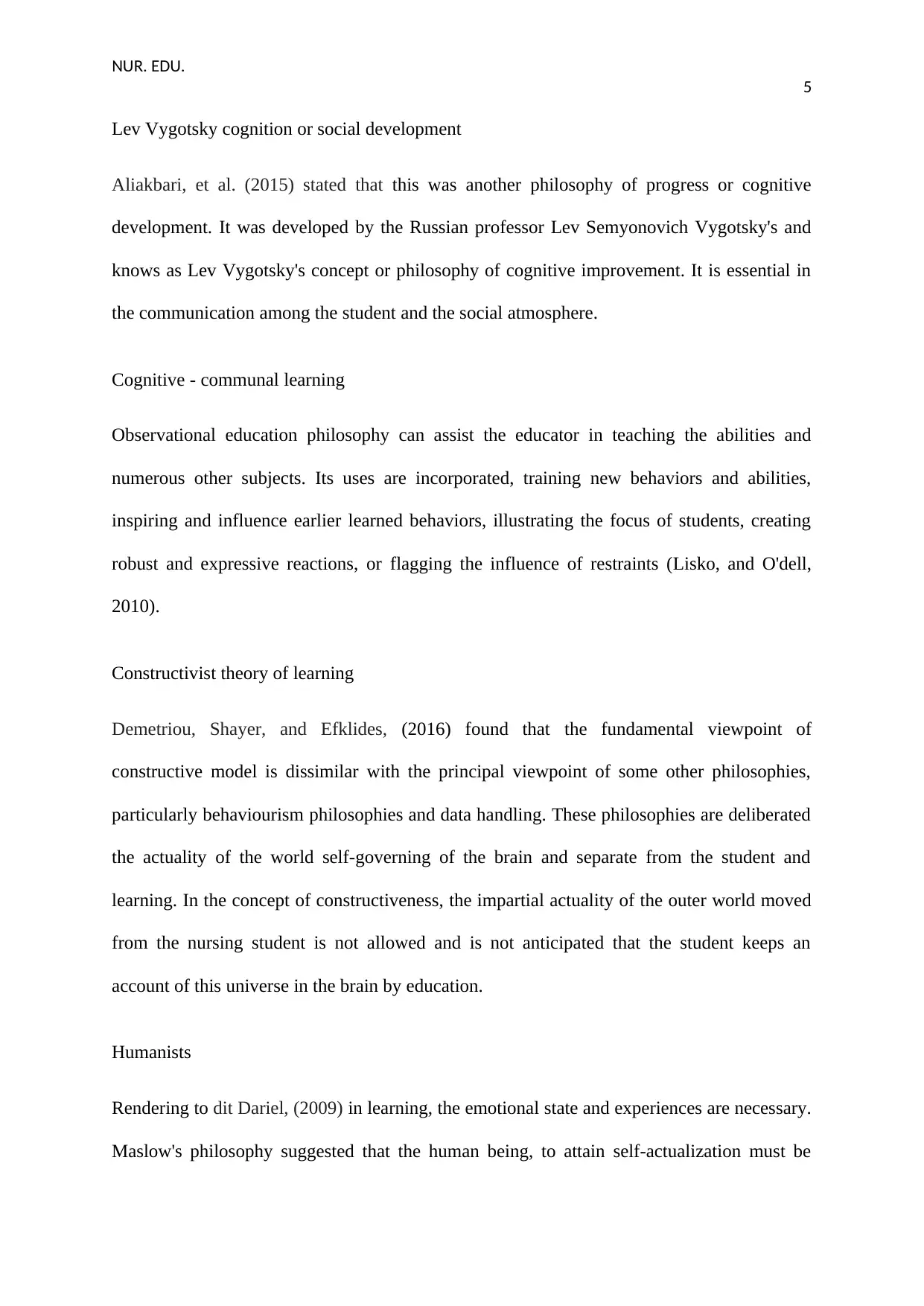
NUR. EDU.
5
Lev Vygotsky cognition or social development
Aliakbari, et al. (2015) stated that this was another philosophy of progress or cognitive
development. It was developed by the Russian professor Lev Semyonovich Vygotsky's and
knows as Lev Vygotsky's concept or philosophy of cognitive improvement. It is essential in
the communication among the student and the social atmosphere.
Cognitive - communal learning
Observational education philosophy can assist the educator in teaching the abilities and
numerous other subjects. Its uses are incorporated, training new behaviors and abilities,
inspiring and influence earlier learned behaviors, illustrating the focus of students, creating
robust and expressive reactions, or flagging the influence of restraints (Lisko, and O'dell,
2010).
Constructivist theory of learning
Demetriou, Shayer, and Efklides, (2016) found that the fundamental viewpoint of
constructive model is dissimilar with the principal viewpoint of some other philosophies,
particularly behaviourism philosophies and data handling. These philosophies are deliberated
the actuality of the world self-governing of the brain and separate from the student and
learning. In the concept of constructiveness, the impartial actuality of the outer world moved
from the nursing student is not allowed and is not anticipated that the student keeps an
account of this universe in the brain by education.
Humanists
Rendering to dit Dariel, (2009) in learning, the emotional state and experiences are necessary.
Maslow's philosophy suggested that the human being, to attain self-actualization must be
5
Lev Vygotsky cognition or social development
Aliakbari, et al. (2015) stated that this was another philosophy of progress or cognitive
development. It was developed by the Russian professor Lev Semyonovich Vygotsky's and
knows as Lev Vygotsky's concept or philosophy of cognitive improvement. It is essential in
the communication among the student and the social atmosphere.
Cognitive - communal learning
Observational education philosophy can assist the educator in teaching the abilities and
numerous other subjects. Its uses are incorporated, training new behaviors and abilities,
inspiring and influence earlier learned behaviors, illustrating the focus of students, creating
robust and expressive reactions, or flagging the influence of restraints (Lisko, and O'dell,
2010).
Constructivist theory of learning
Demetriou, Shayer, and Efklides, (2016) found that the fundamental viewpoint of
constructive model is dissimilar with the principal viewpoint of some other philosophies,
particularly behaviourism philosophies and data handling. These philosophies are deliberated
the actuality of the world self-governing of the brain and separate from the student and
learning. In the concept of constructiveness, the impartial actuality of the outer world moved
from the nursing student is not allowed and is not anticipated that the student keeps an
account of this universe in the brain by education.
Humanists
Rendering to dit Dariel, (2009) in learning, the emotional state and experiences are necessary.
Maslow's philosophy suggested that the human being, to attain self-actualization must be
⊘ This is a preview!⊘
Do you want full access?
Subscribe today to unlock all pages.

Trusted by 1+ million students worldwide

NUR. EDU.
6
slightly gratified with the inferior type of necessities (security and suitability). Thus, the
crucial aim of learning or education is getting to the absolute limit of personal development
potential. Learner-centered perspective has been supported by Carl Rogers and he believed
that into a semantic range, which some constituents are situated on a single side of it deprived
of having an individual understanding for the student.
Model for clinical nursing education and training
Clinical nursing learning and training includes four main stakeholders; the learner, who is the
center of the actions, the wellbeing scheme in which medical education takes place, the
nursing learning institution accountable for the learning programme of the learner, and the
controlling organization which sets the principles for training and education. The
accountability of all of these can be described. Nurse educators are involved in the Nursing
Education Institute and take straight responsibility for the excellence of the medical learning
of nursing scholars (Takase, 2013).
Role in clinical teaching:
Roles of teaching and education support in clinical practice includes an emerging curriculum
with a proficient focus; Accountable for medical teaching and supporting students, through
their training methods, so that learners are capable to incorporate theory with exercise; to
help the student in the modeling of clinical proficiency in the nursing area. It helps the
nursing students to perform (not only perceive) in the medical extent for minimum sixteen
days each year for their personal professional growth and capability (Rolfe Jasper and
Freshwater 2011). The medical area should be associated with the focuses for which they are
accountable. Teaching and education Support clinical training of student by performing an
investigation on the subject helps in running group regulation for scientific preceptors
functioning with the learners they are training to make sure the good quality, staff growth.
6
slightly gratified with the inferior type of necessities (security and suitability). Thus, the
crucial aim of learning or education is getting to the absolute limit of personal development
potential. Learner-centered perspective has been supported by Carl Rogers and he believed
that into a semantic range, which some constituents are situated on a single side of it deprived
of having an individual understanding for the student.
Model for clinical nursing education and training
Clinical nursing learning and training includes four main stakeholders; the learner, who is the
center of the actions, the wellbeing scheme in which medical education takes place, the
nursing learning institution accountable for the learning programme of the learner, and the
controlling organization which sets the principles for training and education. The
accountability of all of these can be described. Nurse educators are involved in the Nursing
Education Institute and take straight responsibility for the excellence of the medical learning
of nursing scholars (Takase, 2013).
Role in clinical teaching:
Roles of teaching and education support in clinical practice includes an emerging curriculum
with a proficient focus; Accountable for medical teaching and supporting students, through
their training methods, so that learners are capable to incorporate theory with exercise; to
help the student in the modeling of clinical proficiency in the nursing area. It helps the
nursing students to perform (not only perceive) in the medical extent for minimum sixteen
days each year for their personal professional growth and capability (Rolfe Jasper and
Freshwater 2011). The medical area should be associated with the focuses for which they are
accountable. Teaching and education Support clinical training of student by performing an
investigation on the subject helps in running group regulation for scientific preceptors
functioning with the learners they are training to make sure the good quality, staff growth.
Paraphrase This Document
Need a fresh take? Get an instant paraphrase of this document with our AI Paraphraser

NUR. EDU.
7
Educators can help the students in optimally connecting the theory with the training and
support; and in the quality assertion of the medical learning practices of learners (Gaberson,
and Oermann, 2010).
Preparation:
The learners and educators should have the education requirement and be a professional in a
practical region of the nursing prospectus. The educators must have nearly 3 to 4 years of
experience in this particular field (Button, Harrington, and Belan, 2014).
Teaching skills:
Suitable nursing study material and appropriate education methods applied by the teachers’
should be shared with the students to help them in practical utilization of. The method of
teaching a skill to the students, the dissimilarity between a skills emphasis and a capability
focus and how this can be taught is important (Numminen, et al., 2013).
Curriculum
The prospectus is the strategy for training and learning advanced by the NEI and must make
clear the situation of medical educating and learning in the complete programme (Rozendo,
Salas, and Cameron, 2017).
Values that help the medical element in the program
Practice suitably related in time with the philosophy (e.g. not model before exercise, not
midwifery philosophy and psychiatric nursing in training); not located for less than the one
month in the medical area for role-taking training, and the facility is completed for both
medical practice for education and experimental exercise for role-captivating.
Learning styles’
7
Educators can help the students in optimally connecting the theory with the training and
support; and in the quality assertion of the medical learning practices of learners (Gaberson,
and Oermann, 2010).
Preparation:
The learners and educators should have the education requirement and be a professional in a
practical region of the nursing prospectus. The educators must have nearly 3 to 4 years of
experience in this particular field (Button, Harrington, and Belan, 2014).
Teaching skills:
Suitable nursing study material and appropriate education methods applied by the teachers’
should be shared with the students to help them in practical utilization of. The method of
teaching a skill to the students, the dissimilarity between a skills emphasis and a capability
focus and how this can be taught is important (Numminen, et al., 2013).
Curriculum
The prospectus is the strategy for training and learning advanced by the NEI and must make
clear the situation of medical educating and learning in the complete programme (Rozendo,
Salas, and Cameron, 2017).
Values that help the medical element in the program
Practice suitably related in time with the philosophy (e.g. not model before exercise, not
midwifery philosophy and psychiatric nursing in training); not located for less than the one
month in the medical area for role-taking training, and the facility is completed for both
medical practice for education and experimental exercise for role-captivating.
Learning styles’
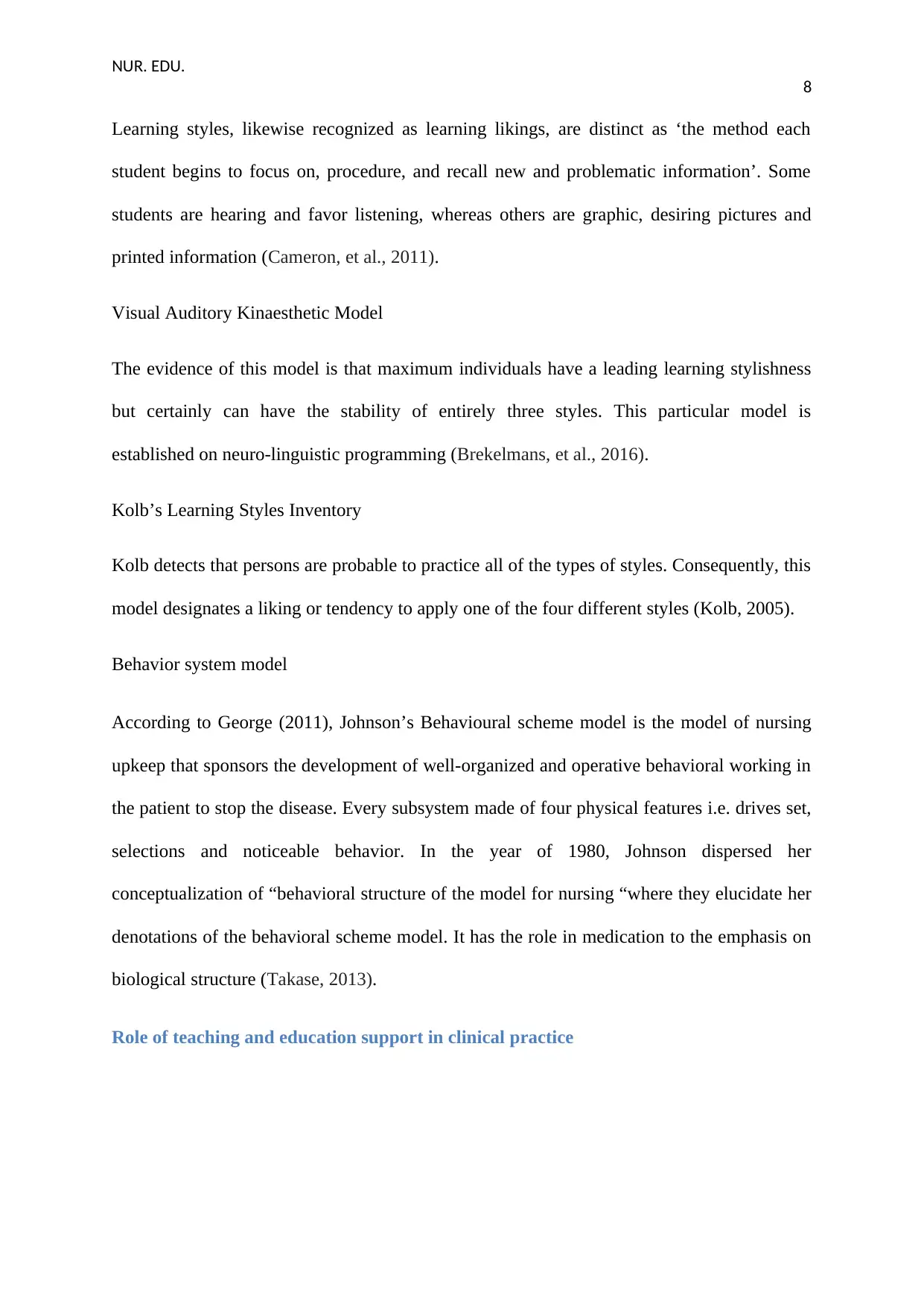
NUR. EDU.
8
Learning styles, likewise recognized as learning likings, are distinct as ‘the method each
student begins to focus on, procedure, and recall new and problematic information’. Some
students are hearing and favor listening, whereas others are graphic, desiring pictures and
printed information (Cameron, et al., 2011).
Visual Auditory Kinaesthetic Model
The evidence of this model is that maximum individuals have a leading learning stylishness
but certainly can have the stability of entirely three styles. This particular model is
established on neuro-linguistic programming (Brekelmans, et al., 2016).
Kolb’s Learning Styles Inventory
Kolb detects that persons are probable to practice all of the types of styles. Consequently, this
model designates a liking or tendency to apply one of the four different styles (Kolb, 2005).
Behavior system model
According to George (2011), Johnson’s Behavioural scheme model is the model of nursing
upkeep that sponsors the development of well-organized and operative behavioral working in
the patient to stop the disease. Every subsystem made of four physical features i.e. drives set,
selections and noticeable behavior. In the year of 1980, Johnson dispersed her
conceptualization of “behavioral structure of the model for nursing “where they elucidate her
denotations of the behavioral scheme model. It has the role in medication to the emphasis on
biological structure (Takase, 2013).
Role of teaching and education support in clinical practice
8
Learning styles, likewise recognized as learning likings, are distinct as ‘the method each
student begins to focus on, procedure, and recall new and problematic information’. Some
students are hearing and favor listening, whereas others are graphic, desiring pictures and
printed information (Cameron, et al., 2011).
Visual Auditory Kinaesthetic Model
The evidence of this model is that maximum individuals have a leading learning stylishness
but certainly can have the stability of entirely three styles. This particular model is
established on neuro-linguistic programming (Brekelmans, et al., 2016).
Kolb’s Learning Styles Inventory
Kolb detects that persons are probable to practice all of the types of styles. Consequently, this
model designates a liking or tendency to apply one of the four different styles (Kolb, 2005).
Behavior system model
According to George (2011), Johnson’s Behavioural scheme model is the model of nursing
upkeep that sponsors the development of well-organized and operative behavioral working in
the patient to stop the disease. Every subsystem made of four physical features i.e. drives set,
selections and noticeable behavior. In the year of 1980, Johnson dispersed her
conceptualization of “behavioral structure of the model for nursing “where they elucidate her
denotations of the behavioral scheme model. It has the role in medication to the emphasis on
biological structure (Takase, 2013).
Role of teaching and education support in clinical practice
⊘ This is a preview!⊘
Do you want full access?
Subscribe today to unlock all pages.

Trusted by 1+ million students worldwide
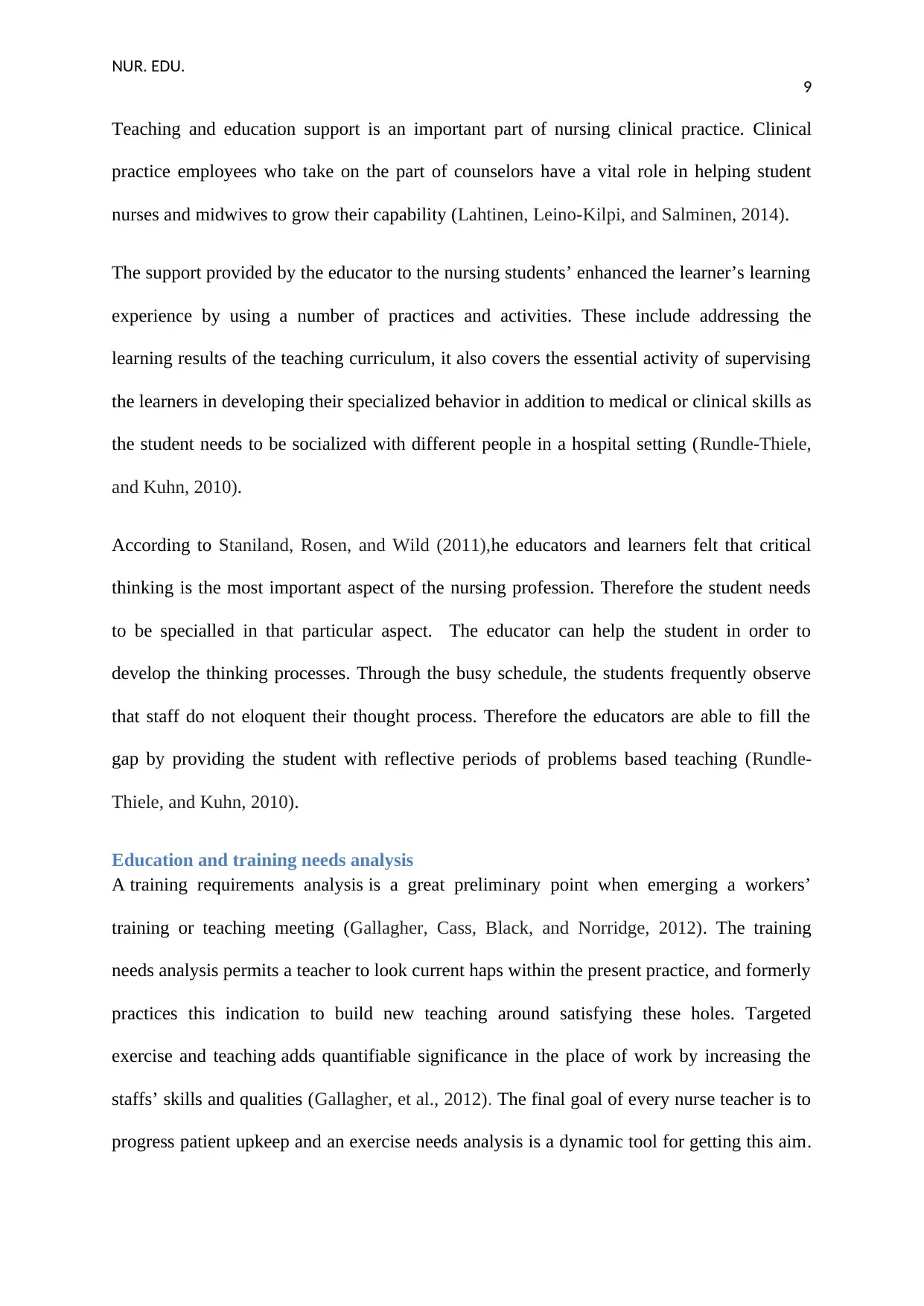
NUR. EDU.
9
Teaching and education support is an important part of nursing clinical practice. Clinical
practice employees who take on the part of counselors have a vital role in helping student
nurses and midwives to grow their capability (Lahtinen, Leino-Kilpi, and Salminen, 2014).
The support provided by the educator to the nursing students’ enhanced the learner’s learning
experience by using a number of practices and activities. These include addressing the
learning results of the teaching curriculum, it also covers the essential activity of supervising
the learners in developing their specialized behavior in addition to medical or clinical skills as
the student needs to be socialized with different people in a hospital setting (Rundle-Thiele,
and Kuhn, 2010).
According to Staniland, Rosen, and Wild (2011),he educators and learners felt that critical
thinking is the most important aspect of the nursing profession. Therefore the student needs
to be specialled in that particular aspect. The educator can help the student in order to
develop the thinking processes. Through the busy schedule, the students frequently observe
that staff do not eloquent their thought process. Therefore the educators are able to fill the
gap by providing the student with reflective periods of problems based teaching (Rundle-
Thiele, and Kuhn, 2010).
Education and training needs analysis
A training requirements analysis is a great preliminary point when emerging a workers’
training or teaching meeting (Gallagher, Cass, Black, and Norridge, 2012). The training
needs analysis permits a teacher to look current haps within the present practice, and formerly
practices this indication to build new teaching around satisfying these holes. Targeted
exercise and teaching adds quantifiable significance in the place of work by increasing the
staffs’ skills and qualities (Gallagher, et al., 2012). The final goal of every nurse teacher is to
progress patient upkeep and an exercise needs analysis is a dynamic tool for getting this aim.
9
Teaching and education support is an important part of nursing clinical practice. Clinical
practice employees who take on the part of counselors have a vital role in helping student
nurses and midwives to grow their capability (Lahtinen, Leino-Kilpi, and Salminen, 2014).
The support provided by the educator to the nursing students’ enhanced the learner’s learning
experience by using a number of practices and activities. These include addressing the
learning results of the teaching curriculum, it also covers the essential activity of supervising
the learners in developing their specialized behavior in addition to medical or clinical skills as
the student needs to be socialized with different people in a hospital setting (Rundle-Thiele,
and Kuhn, 2010).
According to Staniland, Rosen, and Wild (2011),he educators and learners felt that critical
thinking is the most important aspect of the nursing profession. Therefore the student needs
to be specialled in that particular aspect. The educator can help the student in order to
develop the thinking processes. Through the busy schedule, the students frequently observe
that staff do not eloquent their thought process. Therefore the educators are able to fill the
gap by providing the student with reflective periods of problems based teaching (Rundle-
Thiele, and Kuhn, 2010).
Education and training needs analysis
A training requirements analysis is a great preliminary point when emerging a workers’
training or teaching meeting (Gallagher, Cass, Black, and Norridge, 2012). The training
needs analysis permits a teacher to look current haps within the present practice, and formerly
practices this indication to build new teaching around satisfying these holes. Targeted
exercise and teaching adds quantifiable significance in the place of work by increasing the
staffs’ skills and qualities (Gallagher, et al., 2012). The final goal of every nurse teacher is to
progress patient upkeep and an exercise needs analysis is a dynamic tool for getting this aim.
Paraphrase This Document
Need a fresh take? Get an instant paraphrase of this document with our AI Paraphraser

NUR. EDU.
10
The training needs examination is the procedure that discloses practice cavities that present
within an establishment and monitors teachers on how to efficiently close these cavities
(Gould, Kelly, White, and Chidgey, 2004). It aids to control:
What is the specialized exercise gap and why does it occur?
What exercise is desired to fill the gap?
The setting and style of exercise to be delivered
Eventually, founding comprehensive teaching needs analysis at numerous stages of an
establishment along with providing exercise programs that emphasis on the requirements of
the worker and users will importantly subsidize towards the achievement of teaching and
education (Innes-Walker, and Edwards, 2013).
What training is needed?
The information collected from the analysis of training needs and the results greatly educated
the growth and design of the educational setting. The training can be developed that may
deliver nurses within cooperation of theoretical and practical knowledge of how to greatest
effectively upkeep for a diseased person with short term pancreatitis. Various styles of
education can be included such as a video clip that focuses on the key model and established
how an ERCP process is done (Green, et al., 2009).
There are various things that nurse teachers can do to make sure they enhance their exercise
needs examination:
Precise a keen attention in patient upkeep
Inquiry the limits of processes that are presently in place
10
The training needs examination is the procedure that discloses practice cavities that present
within an establishment and monitors teachers on how to efficiently close these cavities
(Gould, Kelly, White, and Chidgey, 2004). It aids to control:
What is the specialized exercise gap and why does it occur?
What exercise is desired to fill the gap?
The setting and style of exercise to be delivered
Eventually, founding comprehensive teaching needs analysis at numerous stages of an
establishment along with providing exercise programs that emphasis on the requirements of
the worker and users will importantly subsidize towards the achievement of teaching and
education (Innes-Walker, and Edwards, 2013).
What training is needed?
The information collected from the analysis of training needs and the results greatly educated
the growth and design of the educational setting. The training can be developed that may
deliver nurses within cooperation of theoretical and practical knowledge of how to greatest
effectively upkeep for a diseased person with short term pancreatitis. Various styles of
education can be included such as a video clip that focuses on the key model and established
how an ERCP process is done (Green, et al., 2009).
There are various things that nurse teachers can do to make sure they enhance their exercise
needs examination:
Precise a keen attention in patient upkeep
Inquiry the limits of processes that are presently in place

NUR. EDU.
11
Involve in informal deliberations with the worker to gain a healthier knowledge of
their specific needs and problems (Gallagher, et al., 2012).
Educators must also not rebate their own information and insight into a condition.
In different cases, it is current knowledge that motivates teachers to conduct a primary
training requirement analysis, which then eventually subsidizes to the on-going delivery of
high-quality care for patients and better results.
Design, implementation, and evaluation of the nursing strategy
There is a number of strategies that can be helpful in nursing education. Simulations
technology is one of the main strategies of those approaches. This method is student-oriented
learning practices, in which the students are permitted to work in an atmosphere that is
similar to the actual world healthcare. Nurse educators applied the patient simulation as the
innovative educating method to reinforce the healthcare concepts and for adopting the
technology (Lahtinen, Leino-Kilpi, and Salminen, 2014).
Design
The simulation-based program is mostly designed by the main investigator in partnership
with nursing educators who helped as subject-matter specialists, delivered input on purposes,
reviewed and recommended amendments to the case situations prior to the implementation of
the programs. The fidelity of the program should also be ensured in order to implement the
program successfully. Student support is another element of the simulation-based approach.
The program designer prepared several orientations to student support emphasizing on the
competence of cues and the process of making those cues obtainable.
Implementation
11
Involve in informal deliberations with the worker to gain a healthier knowledge of
their specific needs and problems (Gallagher, et al., 2012).
Educators must also not rebate their own information and insight into a condition.
In different cases, it is current knowledge that motivates teachers to conduct a primary
training requirement analysis, which then eventually subsidizes to the on-going delivery of
high-quality care for patients and better results.
Design, implementation, and evaluation of the nursing strategy
There is a number of strategies that can be helpful in nursing education. Simulations
technology is one of the main strategies of those approaches. This method is student-oriented
learning practices, in which the students are permitted to work in an atmosphere that is
similar to the actual world healthcare. Nurse educators applied the patient simulation as the
innovative educating method to reinforce the healthcare concepts and for adopting the
technology (Lahtinen, Leino-Kilpi, and Salminen, 2014).
Design
The simulation-based program is mostly designed by the main investigator in partnership
with nursing educators who helped as subject-matter specialists, delivered input on purposes,
reviewed and recommended amendments to the case situations prior to the implementation of
the programs. The fidelity of the program should also be ensured in order to implement the
program successfully. Student support is another element of the simulation-based approach.
The program designer prepared several orientations to student support emphasizing on the
competence of cues and the process of making those cues obtainable.
Implementation
⊘ This is a preview!⊘
Do you want full access?
Subscribe today to unlock all pages.

Trusted by 1+ million students worldwide
1 out of 18
Related Documents
Your All-in-One AI-Powered Toolkit for Academic Success.
+13062052269
info@desklib.com
Available 24*7 on WhatsApp / Email
![[object Object]](/_next/static/media/star-bottom.7253800d.svg)
Unlock your academic potential
Copyright © 2020–2025 A2Z Services. All Rights Reserved. Developed and managed by ZUCOL.




